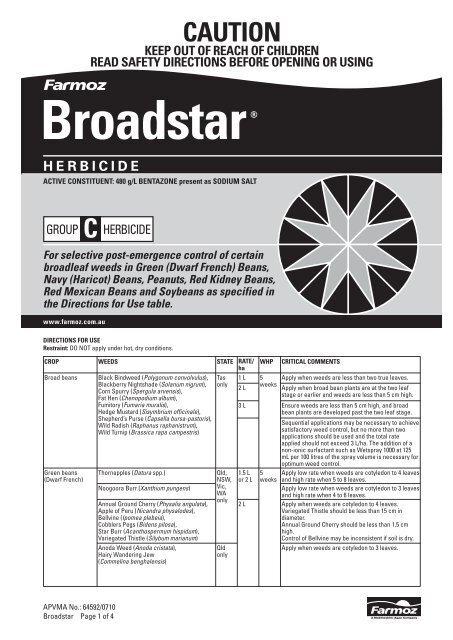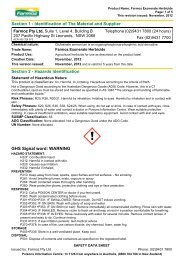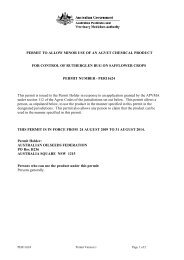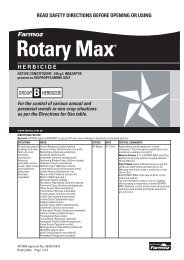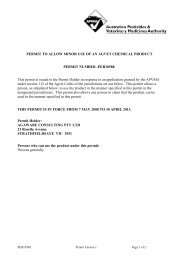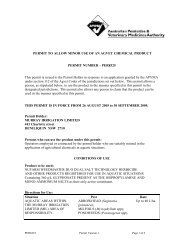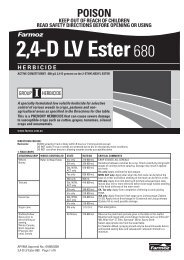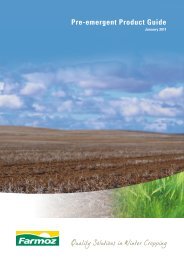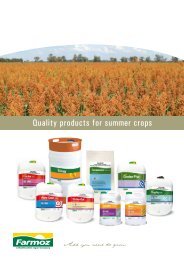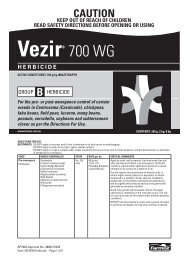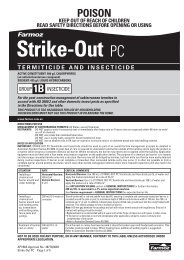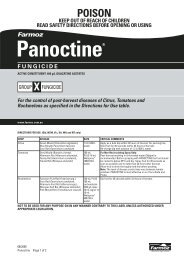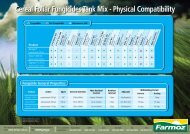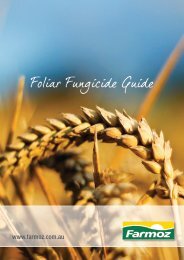BROADSTAR HERBICIDE - Farmoz
BROADSTAR HERBICIDE - Farmoz
BROADSTAR HERBICIDE - Farmoz
Create successful ePaper yourself
Turn your PDF publications into a flip-book with our unique Google optimized e-Paper software.
Broadstar®<br />
ACTIVE CONSTITUENT: 480 g/L BENTAZONE present as SODIUM SALT<br />
For selective post-emergence control of certain<br />
broadleaf weeds in Green (Dwarf French) Beans,<br />
Navy (Haricot) Beans, Peanuts, Red Kidney Beans,<br />
Red Mexican Beans and Soybeans as specified in<br />
the Directions for Use table.<br />
www.farmoz.com.au<br />
DIRECTIONS FOR USE<br />
Restraint: DO NOT apply under hot, dry conditions.<br />
CROP WEEDS STATE RATE/ WHP CRITICAL COMMENTS<br />
ha<br />
Broad beans Black Bindweed (Polygonum convolvulus),<br />
Blackberry Nightshade (Solanum nigrum),<br />
Corn Spurry (Spergula arvensis),<br />
Fat Hen (Chenopodium album),<br />
Fumitory (Fumaria muralis),<br />
Hedge Mustard (Sisymbrium officinale),<br />
Shepherd’s Purse (Capsella bursa-pastoris),<br />
Wild Radish (Raphanus raphanistrum),<br />
Wild Turnip (Brassica rapa campestris)<br />
APVMA No.: 64592/0710<br />
Broadstar Page 1 of 4<br />
CAUTION<br />
KEEP OUT OF REACH OF CHILDREN<br />
READ SAFETY DIRECTIONS BEFORE OPENING OR USING<br />
<strong>HERBICIDE</strong><br />
GROUP C <strong>HERBICIDE</strong><br />
Green beans<br />
(Dwarf French)<br />
Tas<br />
only<br />
Thornapples (Datura spp.) Qld,<br />
Noogoora Burr (Xanthium pungens)<br />
Annual Ground Cherry (Physalis angulata),<br />
Apple of Peru (Nicandra physalodes),<br />
Bellvine (Ipomea plebeia),<br />
Cobblers Pegs (Bidens pilosa),<br />
Star Burr (Acanthospermum hispidum),<br />
Variegated Thistle (Silybum marianum)<br />
Anoda Weed (Anoda cristata),<br />
Hairy Wandering Jew<br />
(Commelina benghalensis)<br />
NSW,<br />
Vic,<br />
WA<br />
only<br />
Qld<br />
only<br />
1 L 5 Apply when weeds are less than two true leaves.<br />
2 L<br />
weeks<br />
Apply when broad bean plants are at the two leaf<br />
stage or earlier and weeds are less than 5 cm high.<br />
3 L<br />
Ensure weeds are less than 5 cm high, and broad<br />
bean plants are developed past the two leaf stage.<br />
Sequential applications may be necessary to achieve<br />
satisfactory weed control, but no more than two<br />
applications should be used and the total rate<br />
applied should not exceed 3 L/ha. The addition of a<br />
non-ionic surfactant such as Wetspray 1000 at 125<br />
mL per 100 litres of the spray volume is necessary for<br />
optimum weed control.<br />
1.5 L 5 Apply low rate when weeds are cotyledon to 4 leaves<br />
or 2 L weeks and high rate when 5 to 8 leaves.<br />
Apply low rate when weeds are cotyledon to 3 leaves<br />
and high rate when 4 to 6 leaves.<br />
2 L<br />
Apply when weeds are cotyledon to 4 leaves.<br />
Variegated Thistle should be less than 15 cm in<br />
diameter.<br />
Annual Ground Cherry should be less than 1.5 cm<br />
high.<br />
Control of Bellvine may be inconsistent if soil is dry.<br />
Apply when weeds are cotyledon to 3 leaves.
CROP WEEDS STATE RATE/ WHP CRITICAL COMMENTS<br />
ha<br />
Green beans<br />
(Dwarf French)<br />
– continued<br />
Navy beans<br />
(Haricot)<br />
Broadstar Page 2 of 4<br />
Blackberry Nightshade (Solanum nigrum),<br />
Black Bindweed (Polygonum convolvulus),<br />
Corn Spurry (Spergula arvensis),<br />
Fumitory (Fumaris muralis),<br />
Fat Hen (Chenopodium album),<br />
Hedge Mustard (Sisymbrium officinale),<br />
Shepherd’s Purse (Capsella bursa-pastoris),<br />
Wild Turnip (Brassica rapa campestris),<br />
Wild Radish (Raphanus raphanistrum)<br />
Annual Ground Cherry (Physalis angulata),<br />
Apple of Peru (Nicandra physalodes),<br />
Bellvine (Ipomea plebeia),<br />
Cobblers Pegs (Bidens pilosa),<br />
Star Burr (Acanthospermum hispidum),<br />
Variegated Thistle (Silybum marianum)<br />
Anoda Weed (Anoda cristata),<br />
Hairy Wandering Jew<br />
(Commelina benghalensis)<br />
Blackberry Nightshade (Solanum nigrum),<br />
Black Bindweed (Polygonum convolvulus),<br />
Corn Spurry (Spergula arvensis),<br />
Fumitory (Fumaris muralis),<br />
Fat Hen (Chenopodium album),<br />
Hedge Mustard (Sisymbrium officinale),<br />
Shepherd’s Purse (Capsella bursa-pastoris),<br />
Wild Turnip (Brassica rapa campestris),<br />
Wild Radish (Raphanus raphanistrum)<br />
Tas<br />
only<br />
Thornapples (Datura spp.) Qld,<br />
NSW,<br />
Vic,<br />
WA<br />
only<br />
Vic,<br />
Tas,<br />
SA<br />
only<br />
Peanuts Thornapples (Datura spp.) Qld<br />
only<br />
Red kidney beans,<br />
red mexican beans<br />
Noogoora Burr (Xanthium pungens)<br />
Noogoora Burr (Xanthium pungens)<br />
Annual Ground Cherry (Physalis angulata),<br />
Apple of Peru (Nicandra physalodes),<br />
Bellvine (Ipomea plebeia),<br />
Cobblers Pegs (Bidens pilosa),<br />
Star Burr (Acanthospermum hispidum),<br />
Variegated Thistle (Silybum marianum)<br />
Anoda Weed (Anoda cristata),<br />
Hairy Wandering Jew<br />
(Commelina benghalensis)<br />
Vic, SA<br />
only<br />
Thornapples (Datura spp.) Qld,<br />
Noogoora Burr (Xanthium pungens)<br />
Annual Ground Cherry (Physalis angulata),<br />
Apple of Peru (Nicandra physalodes),<br />
Bellvine (Ipomea plebeia),<br />
Cobblers Pegs (Bidens pilosa),<br />
Star Burr (Acanthospermum hispidum),<br />
Variegated Thistle (Silybum marianum)<br />
Anoda Weed (Anoda cristata),<br />
Hairy Wandering Jew<br />
(Commelina benghalensis)<br />
Qld<br />
only<br />
NSW,<br />
Vic,<br />
WA<br />
only<br />
Soybeans Thornapples (Datura spp.) Qld,<br />
Noogoora Burr (Xanthium pungens)<br />
Annual Ground Cherry (Physalis angulata),<br />
Apple of Peru (Nicandra physalodes),<br />
Bellvine (Ipomea plebeia),<br />
Cobblers Pegs (Bidens pilosa),<br />
Star Burr (Acanthospermum hispidum),<br />
Variegated Thistle (Silybum marianum)<br />
Qld<br />
only<br />
NSW,<br />
Vic,<br />
WA<br />
only<br />
1 L 5 Apply when unifoliate bean leaf is fully expanded.<br />
2 L<br />
weeks<br />
Apply when first trifoliate bean leaf is fully expanded.<br />
3 L<br />
3 L<br />
1.5 L<br />
or 2 L<br />
2 L<br />
3 L<br />
1.5 L<br />
or 2 L<br />
2 L<br />
1.5 L<br />
or 2 L<br />
2 L<br />
1.5 L<br />
or 2 L<br />
2 L<br />
8<br />
weeks<br />
Apply low rate when weeds are cotyledon to 4 leaves<br />
and high rate when 5 to 8 leaves.<br />
Ensure weeds are less than 5 cm high.<br />
The addition of a non-ionic surfactant such as<br />
Wetpsray 1000 at 125 mL per 100 litres of the spray<br />
volume is necessary for optimum weed control in<br />
Tasmania.<br />
21 days Apply low rate when weeds are cotyledon to 4 leaves<br />
and high rate when 5 to 8 leaves.<br />
Apply low rate when weeds are cotyledon to 3 leaves<br />
and high rate when 4 to 6 leaves.<br />
Apply when weeds are cotyledon to 4 leaves.<br />
Variegated Thistle should be less than 15 cm in<br />
diameter.<br />
Annual Ground Cherry should be less than 1.5 cm<br />
high.<br />
Control of Bellvine may be inconsistent if soil is dry.<br />
Apply when weeds are cotyledon to 3 leaves.<br />
8<br />
weeks<br />
8<br />
weeks<br />
Ensure weeds are less than 5 cm high and second<br />
trifoliate bean leaf is fully expanded.<br />
Apply when weeds are cotyledon to 3 leaves. Ensure<br />
weeds are less than 5 cm high.<br />
If product is applied prior to the full expansion of the<br />
second trifoliate leaf, sequential applications may be<br />
necessary to achieve satisfactory weed control, but<br />
no more than two applications should be used and<br />
the total rate applied should not exceed 3 L/ha.<br />
The addition of a non-ionic surfactant such as<br />
Wetspray 1000 at 125 mL per 100 litres of the spray<br />
volume is necessary for optimum weed control.<br />
Apply low rate when weeds are cotyledon to 3 leaves<br />
and high rate when 4 to 6 leaves.<br />
Apply when weeds are cotyledon to 4 leaves.<br />
Variegated Thistle should be less than 15 cm in<br />
diameter.<br />
Annual Ground Cherry should be less than 1.5 cm<br />
high.<br />
Control of Bellvine may be inconsistent if soil is dry.<br />
Apply when weeds are cotyledon to 3 leaves.<br />
Apply low rate when weeds are cotyledon to 4 leaves<br />
and high rate when 5 to 8 leaves.<br />
Apply low rate when weeds are cotyledon to 3 leaves<br />
and high rate when 4 to 6 leaves.<br />
Apply when weeds are cotyledon to 4 leaves.<br />
Variegated Thistle should be less than 15 cm in<br />
diameter.<br />
Annual Ground Cherry should be less than 1.5 cm<br />
high.<br />
Control of Bellvine may be inconsistent if soil is dry.<br />
Apply when weeds are cotyledon to 3 leaves.<br />
Apply low rate when weeds are cotyledon to 4 leaves<br />
and high rate when 5 to 8 leaves.<br />
Apply low rate when weeds are cotyledon to 3 leaves<br />
and high rate when 4 to 6 leaves.<br />
Apply when weeds are cotyledon to 4 leaves.<br />
Variegated Thistle should be less than 15 cm in<br />
diameter.<br />
Annual Ground Cherry should be less than 1.5 cm<br />
high.<br />
Control of Bellvine may be inconsistent if soil is dry.
CROP WEEDS STATE RATE/ WHP CRITICAL COMMENTS<br />
ha<br />
Soybeans<br />
– continued<br />
Broadstar Page 3 of 4<br />
Anoda Weed (Anoda cristata),<br />
Hairy Wandering Jew<br />
(Commelina benghalensis)<br />
Bathurst Burr (Xanthium spinosum),<br />
Blackberry Nightshade (Solanum nigrum)<br />
(SUPPRESSION ONLY)<br />
Qld<br />
only<br />
NSW<br />
only<br />
2 L 8<br />
weeks<br />
2 L<br />
plus<br />
2 L of<br />
D-C<br />
Trate*<br />
Spray<br />
Adju<br />
vant<br />
per ha<br />
Apply when weeds are cotyledon to 3 leaves.<br />
Apply as a post-emergent spray no later than early 4<br />
leaf stage of the weeds.<br />
NOT TO BE USED FOR ANY PURPOSE, OR IN ANY MANNER, CONTRARY TO THIS LABEL UNLESS AUTHORISED UNDER<br />
APPROPRIATE LEGISLATION.<br />
WITHHOLDING PERIODS (WHP):<br />
PEANUTS: DO NOT HARVEST FOR 21 DAYS AFTER APPLICATION.<br />
BROAD BEANS, GREEN BEANS: DO NOT HARVEST FOR 5 WEEKS AFTER APPLICATION.<br />
NAVY BEANS, RED KIDNEY BEANS, RED MEXICAN BEANS, SOYBEANS:<br />
DO NOT HARVEST FOR 8 WEEKS AFTER APPLICATION.
GENERAL INSTRUCTIONS<br />
RESISTANT WEEDS WARNING<br />
FARMOZ <strong>BROADSTAR</strong> ® Herbicide is a<br />
member of the benzothiadiazole group of<br />
herbicides. <strong>BROADSTAR</strong> is a herbicide which inhibits photosynthesis<br />
at photosystem II. For weed resistance management <strong>BROADSTAR</strong> is a<br />
Group C herbicide. Some naturally-occurring weed biotypes resistant<br />
to <strong>BROADSTAR</strong>, and other Group C herbicides, may exist through<br />
normal genetic variability in any weed population. The resistant<br />
individuals can eventually dominate the weed population if these<br />
herbicides are used repeatedly. These resistant weeds will not be<br />
controlled by <strong>BROADSTAR</strong> or other Group C herbicides.<br />
Since occurrence of resistant weeds is difficult to detect prior to use,<br />
FARMOZ Pty. Ltd. accepts no liability for any losses that may result<br />
from the failure of <strong>BROADSTAR</strong> to control resistant weeds.<br />
APPLICATION<br />
Ground Application: <strong>BROADSTAR</strong> is a contact herbicide and therefore<br />
thorough coverage of the foliage of weeds is essential. To obtain<br />
thorough coverage <strong>BROADSTAR</strong> should be applied through properly<br />
calibrated and maintained spray equipment at a volume of 220 to 440 L<br />
water per ha and pressure of 240 to 340 kPa.<br />
Coverage will be reduced if weeds are being shaded by the crop or by<br />
any other factors such as drift or dusty leaves that prevent the<br />
herbicide reaching target leaves. Best results will be obtained when<br />
conditions favour rapid growth.<br />
Aerial Application: (Read instructions for Ground Application first)<br />
Apply with aircraft fitted with either conventional boom and nozzles or<br />
with Micronair rotary atomizers flying between 3 to 4 metres above the<br />
ground. Booms should be fitted with D8 to D12 nozzles and calibrated<br />
to apply at least 50 L/ha with overlapping swaths to prevent striping.<br />
Micronairs should be calibrated to apply at least 35 L/ha with droplets<br />
between 200 to 250 microns and swaths overlapping to prevent<br />
striping. Avoid droplets smaller than 200 micron as they are<br />
susceptible to evaporation.<br />
DO NOT APPLY under hot and dry conditions. Best results are obtained<br />
from late afternoon or early morning spraying.<br />
DO NOT APPLY under strong or gusty wind conditions (more than 5<br />
knots) as striping will occur.<br />
Split Applications: Weeds do not all germinate at once and application<br />
should not be delayed to catch later germinations. When late<br />
germinations of weeds occur a second application is advisable before<br />
the crop canopy closes.<br />
The Effects of Stress and Weather: Application is not recommended to<br />
crops suffering from stress induced by drought, water logging, hail<br />
damage, frost or injury from other pesticides or crop injury may occur.<br />
Such stress conditions may also harden weeds making them more<br />
difficult to kill.<br />
<strong>BROADSTAR</strong> is a water soluble concentration and hot, dry conditions<br />
may cause spray to evaporate reducing covering and the performance<br />
on weeds. Rain within eight hours of spraying is likely to reduce the<br />
effectiveness of <strong>BROADSTAR</strong> resulting in poor weed control.<br />
Wetting Agent: In Tasmania (only) a non-ionic wetting agent such as<br />
FARMOZ Wetspray ® GROUP C<br />
<strong>HERBICIDE</strong><br />
1000 at 125 mL per 100 litres of the volume should<br />
be added when <strong>BROADSTAR</strong> is sprayed on navy (Haricot) beans and<br />
green (Dwarf French) beans. In general, the addition of wetter does<br />
not improve control of weeds in other areas.<br />
However, with less susceptible weeds or if spray coverage is less than<br />
optimum the addition of Wetspray 1000 may improve control.<br />
MIXING<br />
<strong>BROADSTAR</strong> mixes readily with water. Add the required amount of<br />
<strong>BROADSTAR</strong> to the spray tank when filling and agitate to give even<br />
mixing.<br />
COMPATIBILITY<br />
<strong>BROADSTAR</strong> can be applied after pre-planting application of trifluralin<br />
or EPTC.<br />
PACK SIZE: 10 L, 20 L<br />
Broadstar Page 4 of 4<br />
PROTECTION OF CROPS, NATIVE AND OTHER NON-TARGET PLANTS<br />
DO NOT apply under weather conditions, or from spraying equipment,<br />
that may cause spray to drift onto nearby susceptible plants/crops,<br />
cropping lands or pastures.<br />
CROP SAFETY<br />
Green beans, navy beans, red kidney beans, red mexican beans:<br />
Beans are tolerant of <strong>BROADSTAR</strong> after the first two trifoliate leaves<br />
are fully expanded. There may be leaf scorch but this will not affect<br />
yields.<br />
DO NOT apply unless two trifoliate leaves are present except as per<br />
directions for use in Tasmania on green beans or severe damage may<br />
result. When used in Tasmania do not apply after flower bud formation.<br />
Peanuts: Apply after the crop is 12 cm high.<br />
Soybeans: Soybeans are tolerant of <strong>BROADSTAR</strong> at all stages of<br />
growth. Mild leaf scorching may occur but will not affect yield.<br />
PROTECTION OF WILDLIFE, FISH, CRUSTACEANS AND<br />
ENVIRONMENT<br />
DO NOT contaminate streams, rivers or waterways with <strong>BROADSTAR</strong><br />
or used containers.<br />
STORAGE AND DISPOSAL<br />
Store in the closed, original container in a well-ventilated area, as cool<br />
as possible. DO NOT store for prolonged periods in direct sunlight.<br />
Triple or (preferably) pressure rinse containers before disposal. Add<br />
rinsings to spray tank. DO NOT dispose of undiluted chemicals on-site.<br />
Break, crush, puncture and bury empty containers in a local authority<br />
landfill. If not available, bury the containers below 500 mm in a disposal<br />
pit specifically marked and set up for this purpose clear of waterways,<br />
vegetation and roots. Empty containers and product should NOT be<br />
burnt.<br />
SAFETY DIRECTIONS<br />
May irritate the eyes and skin. Avoid contact with eyes and skin. After<br />
use and before eating, drinking or smoking, wash hands, arms and<br />
face thoroughly with soap and water.<br />
FIRST AID<br />
If poisoning occurs, contact a doctor or Poisons Information Centre.<br />
Phone Australia 131126.<br />
MSDS<br />
Additional information is listed in the material safety data sheet<br />
(MSDS). A material safety data sheet for <strong>BROADSTAR</strong> is available from<br />
FARMOZ on request. Call Customer Service on (02) 9431 7800.<br />
CONDITIONS OF SALE: The use of FARMOZ <strong>BROADSTAR</strong> Herbicide being beyond the<br />
control of the manufacturer, no warranty expressed or implied is given by FARMOZ<br />
Pty. Ltd., regarding its suitability, fitness or efficiency for any purpose for which it is<br />
used by the buyer, whether in accordance with the directions or not and FARMOZ Pty.<br />
Ltd. accepts no responsibility for any consequence whatsoever resulting from the use<br />
of this product.<br />
® Registered trademarks of FARMOZ Pty. Ltd.<br />
* Other trademarks<br />
NOT A DANGEROUS GOOD ACCORDING TO THE<br />
AUSTRALIAN DANGEROUS GOODS (ADG) CODE.


